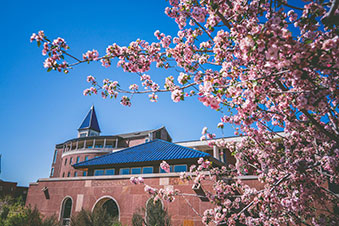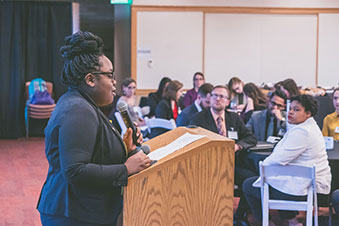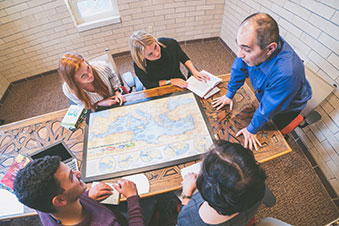What #TakeAKnee Has to do With Higher Education
This week, athletes have become the center of much political conversation as #TakeAKnee takes hold as a political movement. Started last year by NFL star Colin Kaepernick, the Twitter handle refers to athletes kneeling during the national anthem, which is played before many sporting events. But this growing protest movement has been misinterpreted as athletes taking a stand against the American flag and has become mired in conversations about free speech.
As an educator, I see similar critiques of student protests nationwide. In analyzing the #TakeAKnee movement, some have argued that the President and his allies are quick to hide behind a free speech argument when hate speech (a la Charlottesville) is involved, but that athletes' freedom of speech is then challenged. All of this may be true, but this line of argument is missing the point. The larger issue is about who gets to define the American and student experience — the people most affected by justice issues or powerful administrations.
Members of the Trump administration, including the President himself, are at war this week with athletes. Recently, Trump "disinvited" members of the Golden State Warriors basketball team from the customary visit to the White House for NBA champions. In response, sports figures — from LeBron James, to Kobe Bryant, to Steve Kerr — have critiqued the President's mischaracterizations of the #TakeAKnee movement as anti-American.
Similar political bullying takes place in academia. Firings, resignations, angry confrontations, and, recently, physical violence have become increasingly common on college and university campuses. Few would deny that the climate of incivility in contemporary American higher education is affecting the pedagogical success of many colleges and universities. The media and some academic administrators have been quick to identify debates around free speech, diversity, inclusion, trigger warnings, or "coddled" students (i.e. Jonathan Haidt's essay "The Coddling of the American Mind") as the problems. Frequently, they make such claims without offering evidence.
As an anthropologist who has been studiedying campus climate for the past three years through qualitative in-depth research, I have reached different conclusions. Specifically, my research suggests that debates about free speech and academic freedom are a red herring of sorts and have distracted attention from the substantive issues. The results of my study indicate that protests and pressures on college campuses today are actually about what it means to be a student and who defines the student experience.
During the last two years, I have conducted in-depth qualitative research on campus climate, diversity, inclusion, and academic freedom at seven different institutions of higher education, including Pomona College, Claremont McKenna College, Harvey Mudd College, Pitzer College, Scripps College, the University of Denver, and the University of Chicago. I have supplemented my field work by tracking campus climate surveys and studying media coverage of incidents at colleges and universities across the country.
The results of my study analyze the climate of incivility in contemporary American higher education. I argue that failed attempts to reconcile often incompatible versions of reality are generating many of the current tensions on college and university campuses across the United States. Through a preliminary review of my data, I believe that the various constituencies within higher education are talking past, or around, each other. The lines of communication become further challenged by the role of the media, as well as by free speech advocates and other types of activists. For example, a majority of the students with whom I spoke talked about the desire to make changes to curricula, especially to make room for what famed poet and social critic Claudia Rankine has described as their "historical selves."
More than the debates about free speech regularly profiled by the media, campus conflicts are ultimately about who can be a student and what rituals – like flags, mascots, or anthems – performances, and acts define the student experience. As previous roles and definitions of identity fail, students, faculty, and administrators have yet to develop new narratives which better explain their roles.
Just as athletes are pushing us to rethink narratives about who defines America, so too, do students feel the inadequacies of existing campus "stories" to provide a basis for developing new ones which facilitate teaching and learning. Reform and innovation in higher education must reflect and respond to the new demographics of the American campus. And students are not initiating protests in order to stifle free speech, they are speaking back to the institutional violence they have been experiencing through higher education systems that eclipse their historical selves.
What would it look like for major curricular reform to take place that supports students and can be flexible and responsive to the needs of all students? How might we think about a different faculty model, one wherein, for example, faculty offer courses on weekends or evenings, or if they might be able to be "on call" as a part of their service to the college? How can faculty use their training to provide more effective student support? And what happens when student protests calling for recognition of their historical selves are eclipsed and reduced to free speech arguments?
One would be hard pressed to find a college or university with a mission statement that is not designed around the student experience. Yet students today are experiencing elevated levels of pain, as evidenced by increasing student protests and movements that include student demands for change. Although many are trying to fit themselves into institutions of higher education, the institutions themselves have not fundamentally changed to keep pace with demographic changes. The innovations that students and faculty from historically underrepresented groups want to see involves changes in curricula, procedures, rituals, training, and defining who has a platform to express himself or herself. Rituals, like national anthems and flags, are an important symbol of identity, but can also represent or reproduce violence and racism. This is why protests on college campuses, as well as #TakeAKnee are so important, because they are speaking out about the past and present of pain in order to affect change in the future.
Today, social media and nonviolent movement building has given marginalized students and athletes (and student athletes – i.e. Mizzou) the support they may have lacked in the past to speak out. The issues have always been there, but now elevated levels of pain, toxicity, and frustration have inspired people to speak out. It is vital that we understand the what they are trying to communicate and not reduce or eclipse their movements. It's important that the messages be heard.


